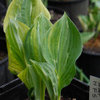HVX - Highlights from Keynote address by Dr Ben Lockhart
Passing along some information from Dr Lockhart's HVX presentation, slides and discussion. Dr Lockhart stated that everything he is presenting should be questioned about how results were obtained since some common believed wisdoms had recently been found incorrect - example item #5 below.
What general lesson were learned from this research project:
1 HVX can be spread from infected to healthy hostas on contaminated tools during normal cutting/pruning of plants.
2 Thorough cleaning of tools with household detergent or 10% bleach or 70% alcohol eliminates contamination virus and prevents HVX spread on tools.
3 HVX was not spread by contaminated knife during division of hosta crowns. This suggest that spread by this means may be significantly less frequent than by cutting tools.
4 The chance of spread of HVX on tools is significantly higher in the spring when plants are vegetatively active than after flowering when plants are approaching senescence.
5 HVX can be spread through soil when healthy hostas are replanted in soil containing HVX-infected residual plant debris. -Hostas (2 of 20) planted in soil from which HVX-infected plant had been removed became infect with the virus. - This method of virus spread was not previously reported for potexviruses, and was totally unexpected.
6 To obtain reliable results hostas used in tests of HVX transmission should be followed through two full growing seasons.
Other comment during presentation - they exposed 20 hostas to infection and none became infected - this led to observation that time of exposure and how exposed may affect infection rates. i.e. after flowering and into fall is less likely to get infected.
Dr. Lockhart during QA period - stated that a cut to leaf and later (for example after 15 min) exposure to HVX virus at injury point would not infect the healthy plant - as the leaf would quickly heal and seal off that entry point. HVX needs to get below outer membrane of a leaf to transmit through sap.
I asked afterward directly - a question that had been raised on this Hosta Forum - If a plant became infected and root zones might be in common with other hosta and since he stated that transmission of HVX is less likely late in season is it better to delay removal till late fall or possibly using Roundup and leaving in place. His feeling was that immediate removal of plant and soil was best, and that he would not use roundup for fear of killing adjacent plant.
The only clear conclusion that came from the study was that there was much we don't know and that previous results may need to be retested in light of what was learned about timing of exposure in particular.
From Presentation -
What new questions do these results raise?
A more detailed investigation of HVX spread in soil including:
-How long does HVX remain infective in plant debris in soil?
-How much HVX infected residue is needed for soil contamination?
-Does infection occur through crowns, roots, or both?
-Does the tyoe if cutting tool affect virus transmission during crown division?
Some other questions of interest:
1. Can hostas recover from HVX infection?
-'Stained Glass' and 'Xanadu Paisley': No sysmptons or HVX detected in previously HVX-positive plants.
2. Can HVX be spread between plants during post-harvest washing in commercial operations?
3. Do we need to revisit previous results about HVX susceptibility in different hosta varieties?
4. Do we need to revisit previous results about the range of plants infected by HVX?
In addition I spoke with the rep for the HVX test strips - and came away believing a properly tested HVX infected plant can not show up negative for HVX - once infected it is throughout the plant and will show in testing. He did a test in front of me and it is very simple and easy - especially after seeing a demonstration.
I tried to recap best as I could what was presented - it was just over a week ago so most is still in there.
I hope others attending will add their observations and recollections as well.
Paul





rbfranklin
paul_in_mnOriginal Author
Related Discussions
spin out bags and buried pots/HVX
Q
AHS Open Garden Tours - Rock Gardens
Q
Good articles on HVX
Q
Dividing hostas in the fall?
Q
idiothe
idiothe
ken_adrian Adrian MI cold Z5
idiothe
paul_in_mnOriginal Author
ken_adrian Adrian MI cold Z5
idiothe